Precision granite components and precision ceramic components occupy a place in the field of materials science, and their performance in hardness, wear resistance and high temperature resistance is different.
When it comes to high temperature resistance, precision ceramic components stand out for their excellent heat stability. Ceramic materials usually have a high melting point, low thermal expansion coefficient and excellent thermal shock resistance, which can maintain a stable structure and performance in extreme high temperature environments. This characteristic makes precision ceramic components have an irreplaceable position in high temperature fields such as aerospace, nuclear energy and chemical industry.
In contrast, precision granite components also have a certain ability to withstand high temperatures, but their performance is relatively weak. Under high temperature conditions, granite may be deformed or cracked due to thermal stress, which affects its use effect. Therefore, in the application scenarios with high temperature requirements, precision ceramic components are undoubtedly a more ideal choice.
Of course, when choosing materials, we can't just rely on a single indicator of high temperature resistance. It is also necessary to consider the hardness of the material, wear resistance, cost, processing difficulty and the specific use of the environment and other factors. For example, in certain applications where high precision and stability are required, precision granite components may be preferred for their good flatness and corrosion resistance.
In summary, precision ceramic components are superior to precision granite components in high temperature resistance, and are more suitable for use in high temperature environments. But in practical applications, we need to make trade-offs and choices according to specific needs to find the most suitable material solution. After in-depth understanding of the differences in high temperature resistance between precision granite components and precision ceramic components, we can further explore the complementarity of the two materials in other key properties and application areas.
Precision granite components, due to their naturally formed high density and uniform structure, not only have excellent stability and flatness, but also show good corrosion resistance and weather resistance. This makes it excellent in situations requiring high precision measurement, stable support or prolonged exposure to harsh natural environments. For example, precision granite components are indispensable in applications such as the base of large precision machine tools, the platform of optical instruments, and the measuring pole in geological exploration.
In addition to its excellent high temperature resistance, precision ceramic components also have high hardness, high strength, good insulation and chemical stability. These properties allow precision ceramics to show great potential in applications where extreme physical and chemical conditions are required. In the aerospace sector, precision ceramic components can be used to manufacture high-temperature components of engines, thermal protection systems and propulsion systems. In the field of energy, precision ceramics can be used to manufacture electrolyte diaphragms for fuel cells, solar panels, etc. In the chemical industry, precision ceramics can be used to make corrosion-resistant reactors, pipes and valves.
With the progress of science and technology and the continuous innovation of technology, the preparation technology of precision granite components and precision ceramic components is also constantly developing. Modern processing technology allows these two materials to be manufactured and processed with higher precision and lower cost, thus further broadening their field of application.
In summary, precision granite components and precision ceramic components have their own unique advantages and scope of application in the field of materials science. In practical applications, we need to choose the right material according to the specific needs and conditions to achieve the best performance and economic benefits. At the same time, with the continuous development of science and technology, we can expect these two materials to play their important roles in more fields and a wider range.
Post time: Aug-05-2024

